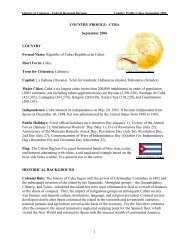Anton Webern's Six Pieces for Ocrhestra, op. 6, Arrangement for ...
Anton Webern's Six Pieces for Ocrhestra, op. 6, Arrangement for ...
Anton Webern's Six Pieces for Ocrhestra, op. 6, Arrangement for ...
Create successful ePaper yourself
Turn your PDF publications into a flip-book with our unique Google optimized e-Paper software.
with similar explicitness. An example from the chamber orchestra version of <strong>op</strong>. 6-the<br />
succession of chords in measures 9-12 of the fourth piece--illustrates this:<br />
The full orchestral version, whose succession of homogenous sonorities (4 flutes, 6<br />
horns, 4 trumpets, etc.) is indebted to an older type of "organ-like" orchestration, 24<br />
reflects the compositional structure in two ways. On the one hand, the grouping of 3<br />
+ 3 chords (separated by a change of registers) is suggested by the similarity of two<br />
timbral processes that move from woodwinds to brass (each starting with the flutes).<br />
On the other hand, the contrasting internal structure of the two chord groups--the<br />
first being symmetrical and circular, 25 the second progressive and <strong>for</strong>warddirected<br />
26--is expressed through different shadings in the timbral processes,<br />
especially since the trumpet timbre of the third chord, pianissimo, is closely related<br />
to the low flute timbre, 27 whereas the timbres of clarinet and trombone in the fifth<br />
and sixth chords gradually depart from it. In the arrangement, Webern could not<br />
render these timbral progressions through successions of homogenously colored<br />
chords because he had only three unified "chord colors" at his disposal (harmonium,<br />
piano, strings) instead of the original five. He there<strong>for</strong>e aimed at a mixture which, in<br />
its own way, would produce a fivefold gradation. In the process, a timbral<br />
"assonance" between chords one and four moves to chords three and six (the<br />
individual mixtures of chords one and three are "homogenized" in the succeeding<br />
chords and resolved to the pure harmonium sound of chords three and six); yet the<br />
chord groupings (3+3) are still suggested in the new instrumentation, in that the<br />
harmonium is heard in chords one and three of the first group, whereas there is no<br />
such repetition of sonority in the second. Thus an analogous result is obtained by<br />
totally different means: the mixture caused by "soloistic instrumentation" serves to<br />
highlight the same compositional features as the changes of sonority in the<br />
orchestral version.<br />
A final aspect of the chamber version of <strong>op</strong>. 6 involves its place in the general



![Albert Einstein Papers [finding aid]. Library of Congress. [PDF ...](https://img.yumpu.com/21604228/1/190x245/albert-einstein-papers-finding-aid-library-of-congress-pdf-.jpg?quality=85)





![American Colony in Jerusalem Collection [finding aid]. Library of ...](https://img.yumpu.com/17941275/1/190x245/american-colony-in-jerusalem-collection-finding-aid-library-of-.jpg?quality=85)



![Piccard Family Papers [finding aid]. - American Memory - Library of ...](https://img.yumpu.com/17941234/1/190x245/piccard-family-papers-finding-aid-american-memory-library-of-.jpg?quality=85)


